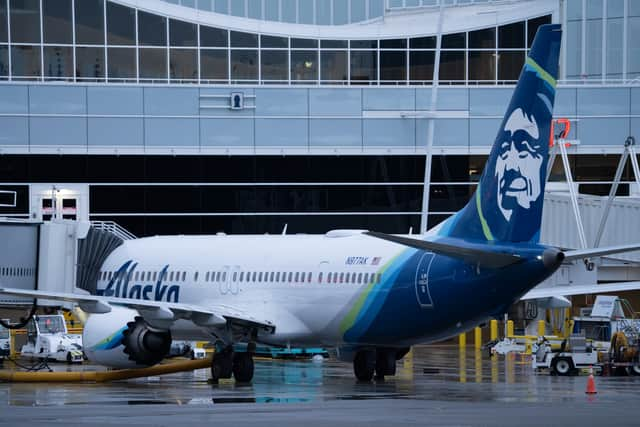Alaska Airlines flight door: Boeing 737 Max 9 plane scheduled for safety check on day of window blow out
and live on Freeview channel 276
On the day a door plug blew out of the Alaska Airlines Boeing 737 Max 9 flight on 5 January, it has been revealed that the plane was scheduled for a safety check. The New York Times reports that interviews and documents show that the plane was kept in service despite engineers and technicians wanting the plane to come out of service the next evening and undergo maintenance.
The engineers were concerned about the mounting evidence of a problem. The plane carried passengers until it completed three flights that were scheduled to end that night in Portland, Oregon.
Advertisement
Hide AdAdvertisement
Hide AdBefore the plane could complete that scheduled sequence of flights and go in for the maintenance check, the door plug blew out at 16,000 feet. It was the second flight of the day from Portland to Ontario International Airport in California.
The plane landed safely and no one was seriously injured, but the Federal Aviation Administration (FAA) quickly ordered the grounding of this fleet of aircraft. According to The New York Times, Alaska Airlines confirmed the sequence of events but said the warnings it had on the plane did not meet its standards for immediately taking it out of service.


After the incident, a US official revealed that a warning light had come on in the days leading up to the Alaska Airlines blowout. Jennifer Homendy, chair of the US National Transportation Safety Board (NTSB), said Alaska Airlines decided to restrict the aircraft from long flights over water so the plane "could return very quickly to an airport" if the warning light reappeared.
Alaska Airlines has repeatedly asserted that there is no evidence that the warning lights were related to the impending plug blowout, The New York Times reports. In addition to the flashing lights, investigators say the door plug had also been gradually sliding upward, but the airline said its visual inspection in the days leading up to the blowout did not reveal any movement of the door plug.
Advertisement
Hide AdAdvertisement
Hide AdBoeing has been under intense scrutiny since the incident. A six-week audit into the firm and its subcontractor Spirit AeroSystems has found “dozens” of quality control problems including dish soap and hotel key cards being used on parts of planes.
The audit run by the Federal Aviation Administration (FAA) found that mechanics working for Spirit were observed using Dawn dish soap on a door seal in place of lubricant. The seal was then reportedly cleaned up with a “wet cheesecloth.”
A spokesperson from Spirit, Joe Buccino, told the Times that the manufacturer was “reviewing” any identified issues for “corrective action.” Meanwhile the FAA has given Boeing 90 days to address shortcomings in its quality control.
Comment Guidelines
National World encourages reader discussion on our stories. User feedback, insights and back-and-forth exchanges add a rich layer of context to reporting. Please review our Community Guidelines before commenting.
